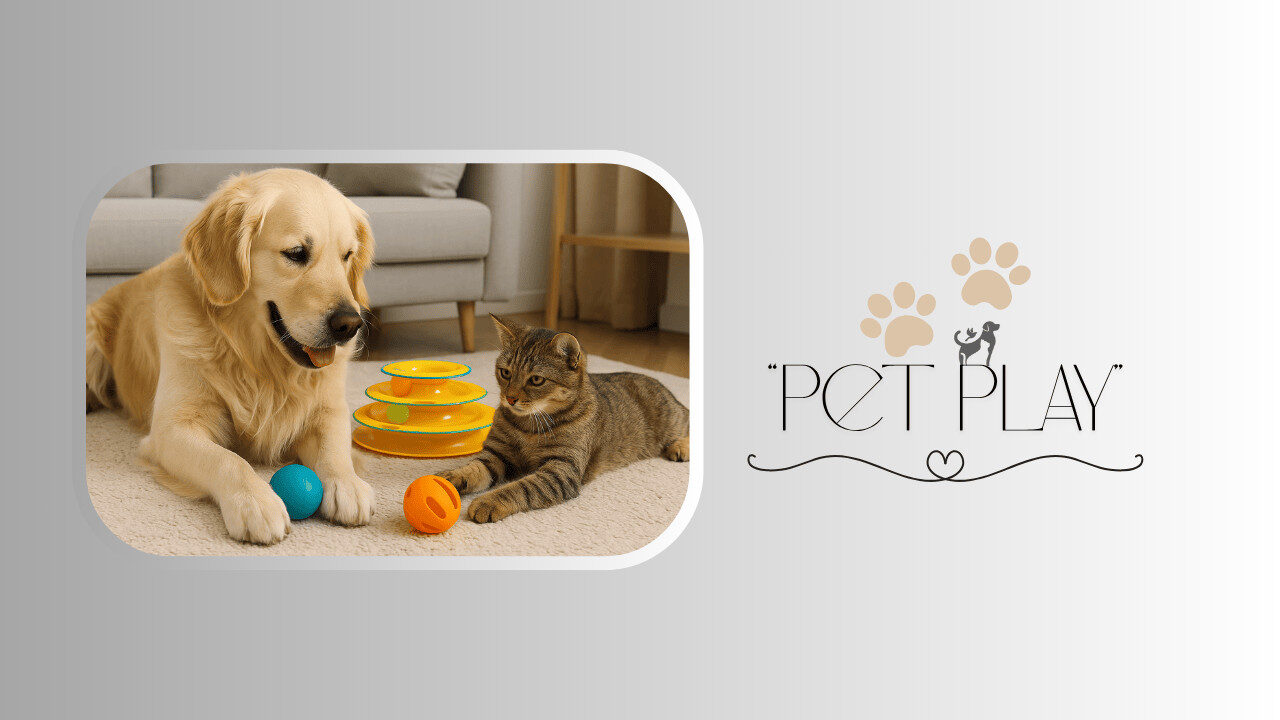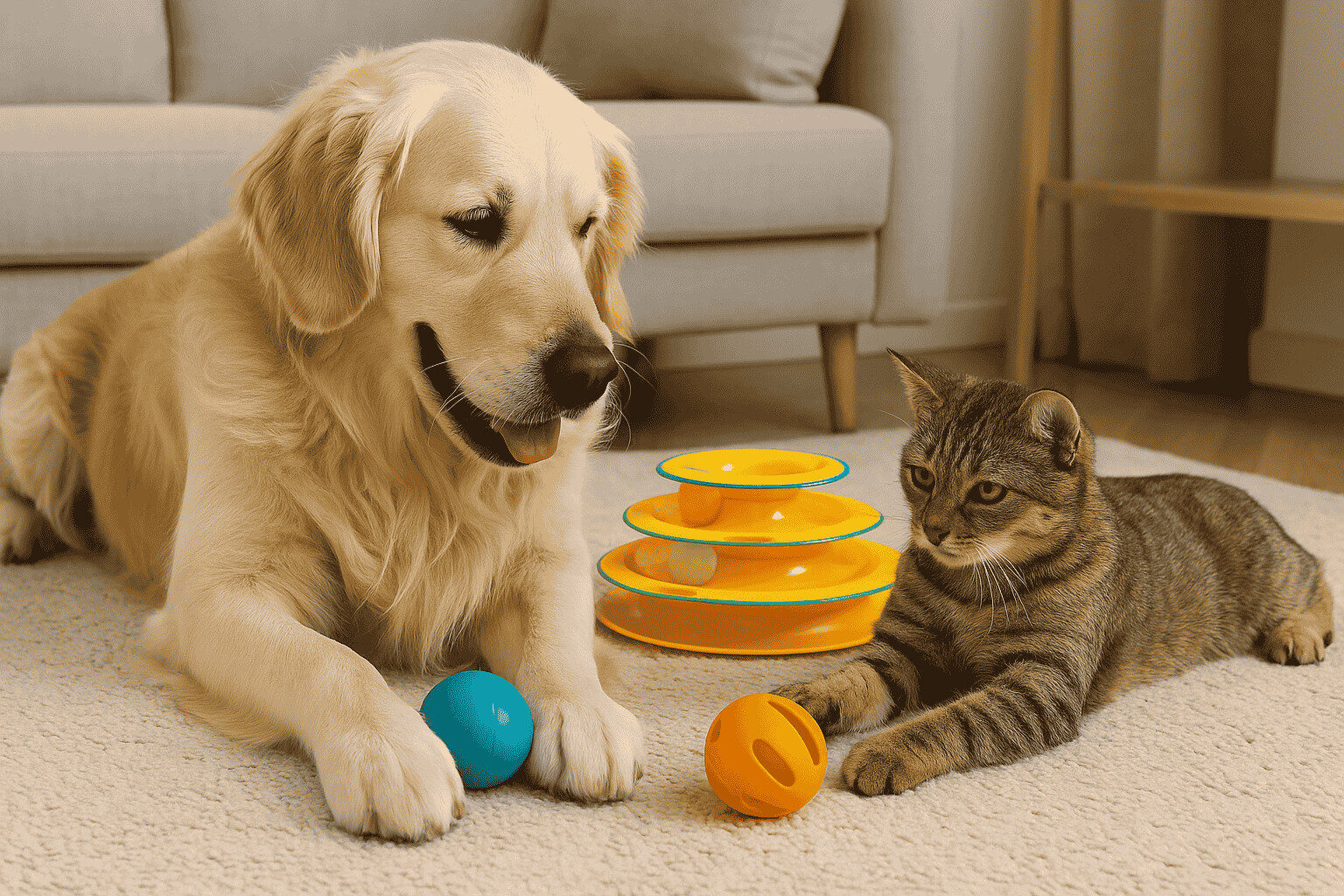If you’re Googling “pet play”, you’re already on the right track. Playtime isn’t just for fun — it’s crucial for your pet’s physical health, mental stimulation, and emotional bonding.
Pets need more than just food and shelter. Without regular interactive pet toys or structured activities, dogs and cats can become:
- Bored
- Destructive
- Anxious or depressed
Engaging in daily dog playtime activities or cat enrichment games can make all the difference.
Most pet owners don’t realize just how much of their pet’s behavior is linked to unmet play needs — I sure didn’t at first!
The Benefits of Regular Playtime
Here’s what consistent pet playtime provides:
- Exercise: Keeps joints healthy and weight in check.
- Bonding: Strengthens the connection between you and your pet.
- Mental enrichment: Helps prevent boredom-related behaviors.
- Confidence: Particularly for shy or adopted pets.
- Problem-solving: Through puzzle toys for pets or training-based games.
According to ASPCA, regular play reduces stress and helps pets adjust to new environments.
Interactive Pet Toys That Actually Work
When it comes to toys, not all are created equal. A good interactive pet toy is more than just a chewable — it challenges your pet’s body and brain.
For Dogs
- Treat-dispensing balls: Great for solo play
- Tug-of-war ropes: Perfect for bonding
- Squeaky plushies: Good for fetch or cuddling
For Cats
- Laser pointers: Stimulate natural hunting instincts
- Feather wands: Interactive and fun for all ages
- Ball towers or track toys: Keeps indoor cats busy
I once bought a puzzle toy for my dog Max and was shocked to see how long he stayed focused — sniffing, pawing, and solving it like a pro.
Indoor Pet Games to Try at Home
Stuck inside on a rainy day? Try these indoor pet games to beat the boredom:
1. Find the Treat
Hide small treats around a room and let your dog sniff them out. For cats, hide bits of dry food or freeze-dried meat.
2. Toy Rotation
Rotate your pet’s toys weekly. This keeps interest high without having to buy new ones constantly.
3. DIY Pet Games
Create a simple DIY pet game using cardboard boxes or paper towel rolls. Hide treats inside and let your pet dig them out.
4. Tug-of-War for Dogs
Simple yet powerful, tug is a fantastic way to exercise your pup indoors.
These games aren’t just fun — they’re excellent for mental stimulation for pets of all ages.
Outdoor Pet Play Ideas for More Active Pets
Outdoor activities offer more room and sensory stimulation. Here are some safe, structured ideas:
For Dogs
- Fetch games: Classic, but never outdated
- Pet agility training: Set up cones or tunnels in your yard
- Dog park visits: Encourages social play for pets
For Cats
- Leash walks (yes, really!)
- Enclosed patios or “catios” for supervised exploration
- Bird-watching perches to stimulate curiosity
Always ensure outdoor areas are secure. Safety first!
Mental Stimulation and Enrichment Activities
Mental exercise can be just as tiring — and beneficial — as physical activity.
Try These:
- Puzzle toys for pets: Hide treats inside and let them figure it out.
- Training sessions: Use basic obedience or trick training to challenge their brains.
- Snuffle mats: Encourage natural foraging behavior.
- Pet bonding activities: Gentle brushing, massage, or even dog yoga sessions.
Mental enrichment improves mood, reduces hyperactivity, and enhances focus.
Real-World Pet Play: My Experience with Luna & Max
Luna, my tabby cat, is notorious for 3 a.m. zoomies. Once I introduced cat enrichment games like a rolling treat ball and climbing shelves, her nighttime energy finally found a daytime outlet.
Max, my Labrador, needed more stimulation beyond walks. We started using pet playtime ideas like scent games and outdoor pet play in a nearby field. Now, he’s happier — and I’m not tripping over chewed-up shoes anymore.
It’s not about being a “perfect” pet parent — just a present one.
FAQs
1. How often should I play with my pet?
Ideally, you should engage in daily pet play. Dogs often need 30–60 minutes, while cats benefit from several short 10–15 minute sessions spread throughout the day.
2. What are good indoor games for pets?
Games like find the treat, tug-of-war for dogs, DIY pet games, and using interactive pet toys are perfect for indoor fun.
3. Are puzzle toys really worth it?
Absolutely. Puzzle toys for pets offer mental stimulation and can even reduce anxiety or boredom-induced behaviors.
4. Can I play with my cat outside?
Yes — with the right gear like a harness or enclosed patio. Outdoor pet play for cats must always be supervised.
5. How do I know if my pet is bored?
Signs include:
- Chewing furniture
- Pacing
- Over-sleeping
- Barking or meowing excessively
Adding structured pet bonding activities can make a noticeable difference.
Final Thoughts & CTA
Play isn’t just a bonus — it’s a basic need. Whether it’s through interactive toys, mental enrichment, or simply spending quality time together, pet play helps build a stronger, happier, and healthier bond between you and your furry companion.
So next time your pet looks at you with those playful eyes — go grab that toy!
Looking for more real-life pet care tips, games, and product ideas?
👉 Visit Fluffze.com — your trusted guide for raising confident, active, and healthy pets.
Share this post with your favorite pet parents and start building playtime into every day!
Written by David Foster, pet lover & contributor at Fluffze
Nose Work Games for Dogs: Mental Enrichment Ideas
Living with a Blind Cat: Tips for a Safe and Happy Life
Best Dog Breeds for Scent Work: Top Picks for Nose Work






